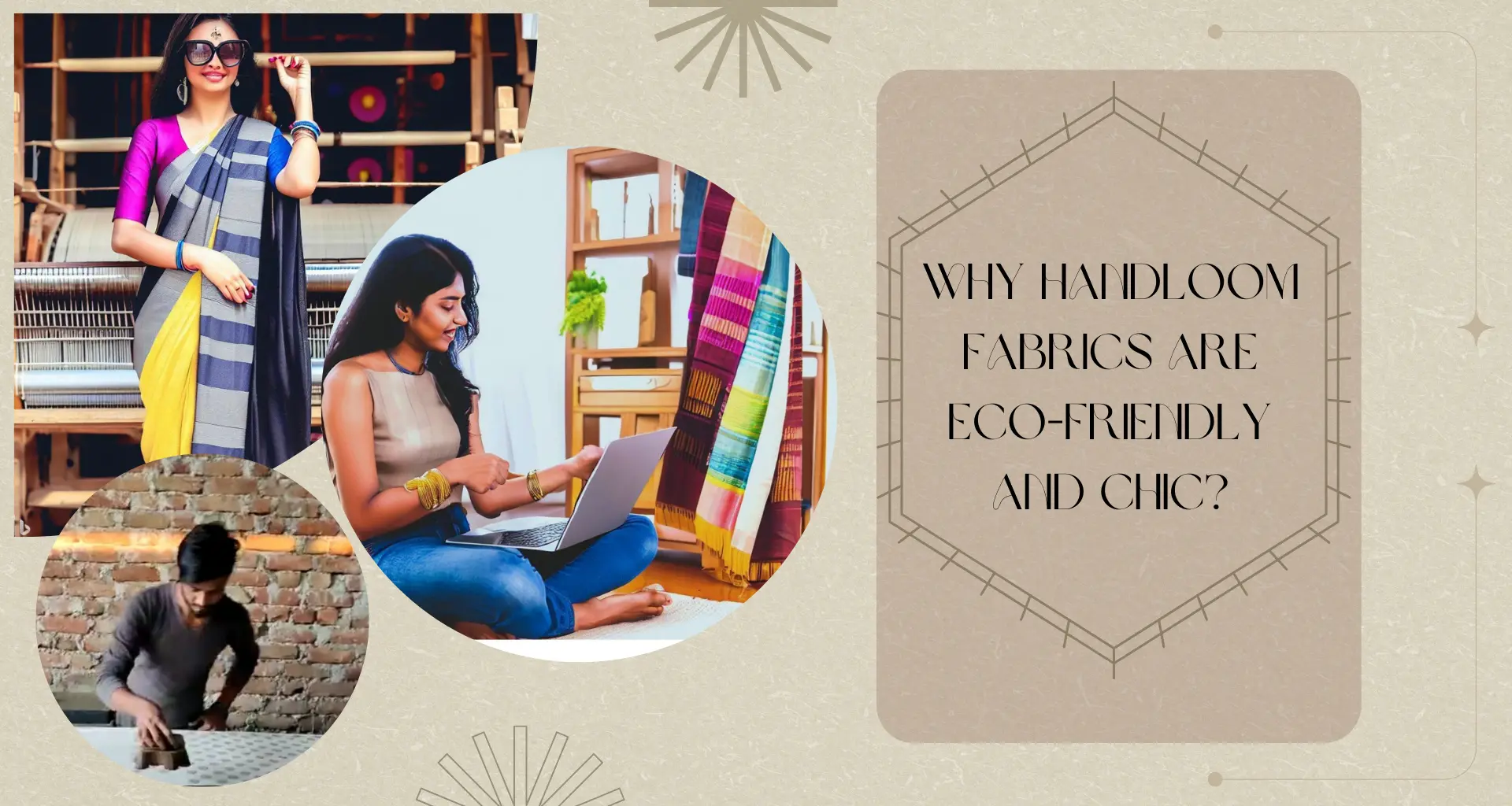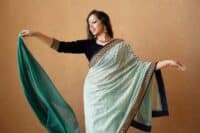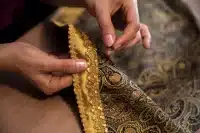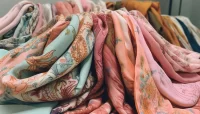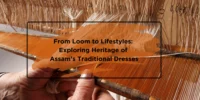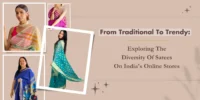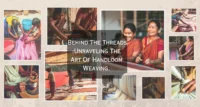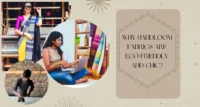Currently, many industries worldwide are focusing on sustainability in their operations.
The fashion industry, in particular, has been making significant efforts to reduce waste, energy consumption, and the fast fashion trend. However, the need for sustainable clothing has become urgent due to growing concerns about the amount of daily waste being generated.
Sustainable fashion involves ethical practices and environmental sensitivity, ensuring that current resources are used efficiently without compromising the needs of future generations. This approach covers everything from sourcing fabrics to production and sales, all aimed at reducing the carbon footprint.
One example of sustainable textile weaving is Handloom, which dates back to the Indus Valley Civilization. Handloom weaving doesn’t rely on electric machinery, and the fabrics are woven by skilled craftsmen who handle the material gently, making the cloth more durable and long-lasting.
Handloom: A Brief History
In post-independent India, the charkha played a significant role in converting cotton into cloth. Every village had its own weaving society, producing Handwoven and Handspun fabrics using small tools like charkhas.
Before independence, the British realized industrialization was more profitable than handwoven cloth. As a result, India became a raw cotton exporter. When British officials brought machine-made yarn into the country, many weavers were forced to stop weaving, causing a loss of jobs for most of them. The handloom business declined over time due to conflicts caused by intermediaries. With the introduction of machinery and electric looms, handlooms became outdated.
After 1945, handlooms and spinning mills continued to operate in India, but many weaving houses started using machine-spun yarn. Fabrics made from this process were called Handloom or handwoven, while fabrics from handspun yarn were known as khadi fabrics. After independence, handloom fabrics faced little competition and were affordable to the general public, making them widely used and accessible.
However, since 1985, especially during the liberalization of the 1990s, the handloom sector faced challenges from low-cost imports and imitation designs from power loom factories. Additionally, government support and policies declined due to economic struggles. Consequently, the cost of natural fiber yarn soared, making it difficult for people with fixed wages to afford it. Handloom weavers’ income remained stagnant while material prices rose over the years.
India’s handloom industry boasts a rich history of exquisite artistry, surpassing many other countries in its diverse textile tradition. Various designs are created using different techniques, influenced by the region’s location, climate, and cultural factors. Artisans from the northern regions are known for their colorful weaving, and intricate embroidery often adorns the fabrics.
Sustainable Fashion: Why Handloom Fabrics is Eco-Friendly Fabric
Every step of the handloom process is done in a way that protects the environment and uses fewer resources.
- The materials used in Handloom, such as natural fibers, are biodegradable and not made with harmful chemicals. The dyes used for coloring the fabric come from natural sources like turmeric, indigo, henna, dogwood bark, and dandelion. These dyes are safe for both our skin and the environment.
- Handloom fabrics are often made to order to reduce waste, meaning they are produced specifically for each customer’s needs. Any leftover materials are creatively used for creating other designs, minimizing unnecessary waste.
- The handloom process is manual, meaning it doesn’t require electricity or water and doesn’t release carbon emissions, making it an environmentally friendly way of producing fabrics.
- Weavers primarily work from their homes, providing them better working conditions and fair wages than those working in power loom factories. This makes the handloom industry a socially responsible choice as well.
Sustainability in fashion
The fashion industry releases as much greenhouse gases every year as the combined economies of France, Germany, and the United Kingdom. To prevent surpassing the 1.5-degree climate change limit set by the Intergovernmental Panel on Climate Change and the 2015 Paris Agreement, the industry must cut its emissions by about half before 2030.
Why is Sustainable Fashion Important?
Less Waste
The world is expected to produce around 3.4 billion metric tons of solid waste by 2050 due to consumer habits, urbanization, and population growth. Sustainable fashion brands aim to reduce waste by making durable clothing from high-quality materials. They refrain from following short-lived fashion trends, resulting in less waste over time.
Fair Treatment of Workers
Many fast fashion companies produce cheap clothes and frequently launch new collections, often sourcing their products from developing countries. In these places, workers are often underpaid, work long hours, and face unsafe conditions. There are even cases of child labor being used. On the other hand, sustainable clothing companies prioritize fair wages and a safe work environment for their workers.
Lower Carbon Emissions
Sustainable clothing is made from biodegradable materials, such as natural or recycled fibers. These materials require less energy and water during production and do not involve harmful chemical treatments. As a result, sustainable fashion brands have a smaller carbon footprint than traditional fashion brands.
Handloom Fabrics: Weaving Sustainability to Fashion
In India, the looms used for weaving fabric vary based on the region and the specific raw materials. For instance, the looms used to weave Pashmina and Kani shawls are made of fine threads derived from softwood, with lightweight spindles used for spinning. Handlooms are unique because the techniques and equipment are passed down from generation to generation, unaffected by environmental changes.
The weavers and artisans have dedicated their lives to this craft, employing age-old techniques and incorporating imaginative motifs and century-old folklore. Their families have maintained sustainable processes over the years, making Eco friendly clothing an inherent part of their tradition rather than a recent reform.
While some mechanical instruments have been introduced to enhance productivity, the core values of sustainability remain intact in most parts of India. Ethical clothing manufacturing practices are also crucial components of sustainability. Artisans and conservation groups strive to minimize waste during production, making handlooms one of the closest approaches to zero-waste manufacturing.
Various groups and societies in India are committed to ensuring a steady income for weavers and artisans. They organize awareness activities like intercity exhibitions, summer camps, and custom projects for bridal parties to promote Eco friendly clothing.
Handloom items are made from natural and environmentally favorable raw materials. For example, Mysore silk sarees use Mulberry silk, delicate chanderi silk, tussah silk, and cotton mulmuls of Madhubani. Other popular materials include:
- Kosa, a special type of tussar.
- Giccha, a more durable silk.
- Pure silk, crepe, and chiffon are used in Jammu & Kashmir.
- High-quality pashmina wool.
- The cotton is used in Kota Doria and Chettinads, among others.
The diversity of raw materials allows for distinctive end products, connecting nature with consumers and ensuring minimal environmental impact. Not only are eco-friendly materials used for the raw fabrics, but also for the compounds used in processing and treatments. Natural colors derived from vegetables, plants, or minerals have a long history in the handloom industry.
Futureproof your Fashion with Sustainable Handloom
As slow fashion becomes dominant in the market, more and more people are actively embracing eco-friendly clothing because of its durability. Handloom garments are made without power, and all raw materials are sourced naturally and ethically, promoting green fashion. This approach minimizes material waste and creates valuable employment opportunities in rural India. These combined factors make the handloom industry one of the most environmentally friendly and sustainable choices in the fashion world.
The constant cycle of discarding and replacing fashion items has changed consumers’ attitudes toward the emotional value of their possessions—marketing and advertising focus on increasing sales rather than promoting genuine values.
However, it can change their perspective if consumers are made aware of the stories behind handlooms and the beautiful craftsmanship involved. These stories are as lovely as the handwoven goods themselves. That’s why it’s essential to revitalize the handloom industry instead of relying solely on mass-produced items. Doing so can encourage a shift towards appreciating meaningful and sustainable products.
Conclusion
While the road to sustainability is complex, understanding what constitutes genuinely sustainable and ethical fashion is now more critical than ever. Eco friendly clothing should not be an exception but the norm. Shopping sustainability is an individual’s choice. However, several designers have been making eco-friendly clothing at reasonable rates for a while now.
FAQs
How can I identify sustainable fabric from others?
You can identify sustainable fabric by looking for certifications, such as GOTS (Global Organic Textile Standard) or OEKO-TEX, checking for organic or recycled materials, and researching the brand's commitment to sustainability.
What is handloom?
Handloom is a traditional method of weaving fabric where the loom is operated manually, without the use of electricity. This technique often involves skilled artisans creating unique and sustainable textiles.
What are some sustainable fashion examples?
Some sustainable fashion examples include clothing made from organic cotton, recycled polyester, hemp, bamboo, or innovative materials like Tencel and Piñatex (made from pineapple fibers). Also, upcycled or vintage clothing are sustainable choices.
What are some best websites for sustainable fashion shopping?
One of the best websites for sustainable fashion shopping is The Loom Lane. With the collection of a wide range of eco-friendly and ethically produced clothing, The Loom Lane aims to promote Handloom in and beyond India.
Why is sustainable clothing called second-hand clothing?
Sustainable clothing is sometimes referred to as second-hand clothing because it includes pre-owned or vintage items that have been gently used or passed down, promoting the idea of reusing and extending the life of clothing to reduce waste.


